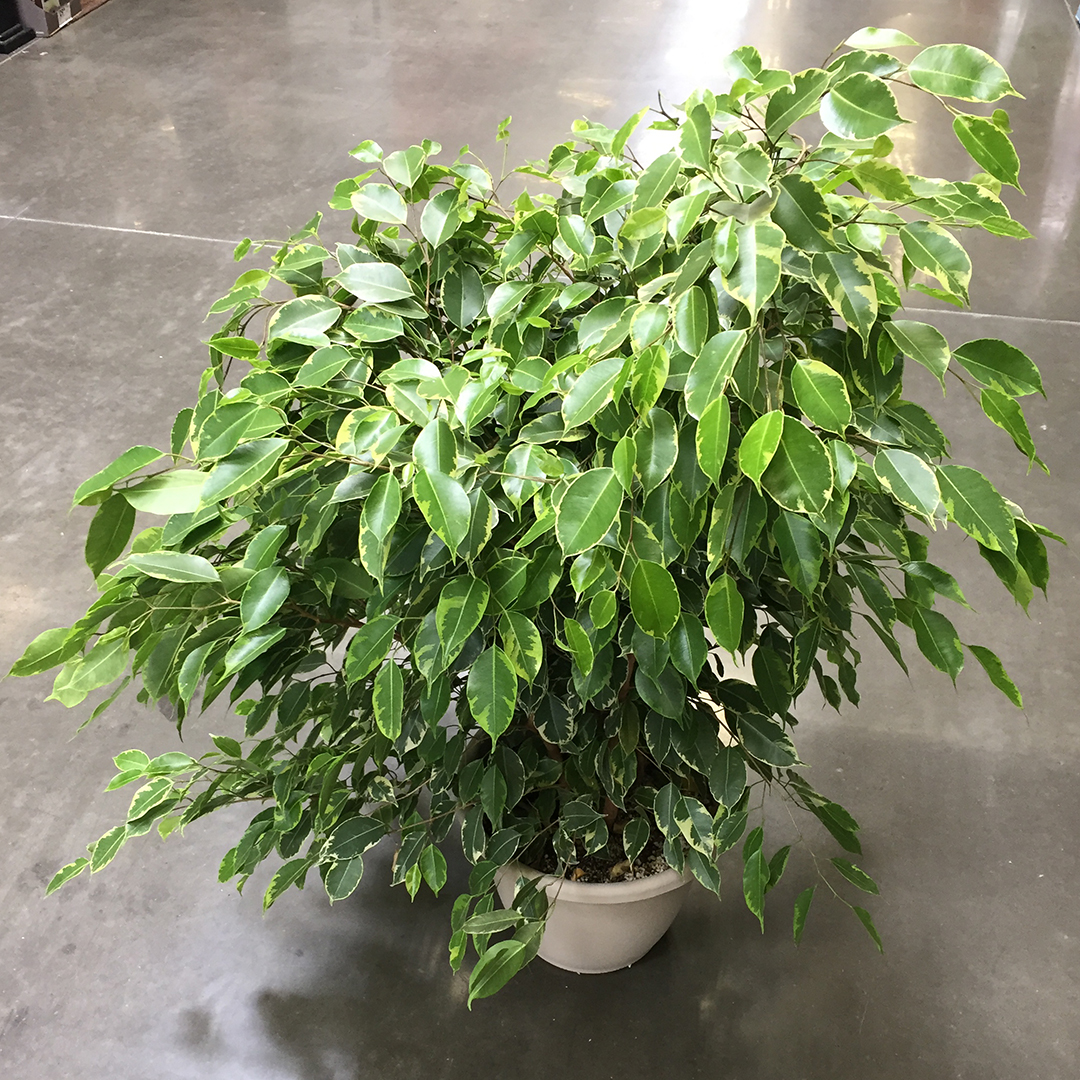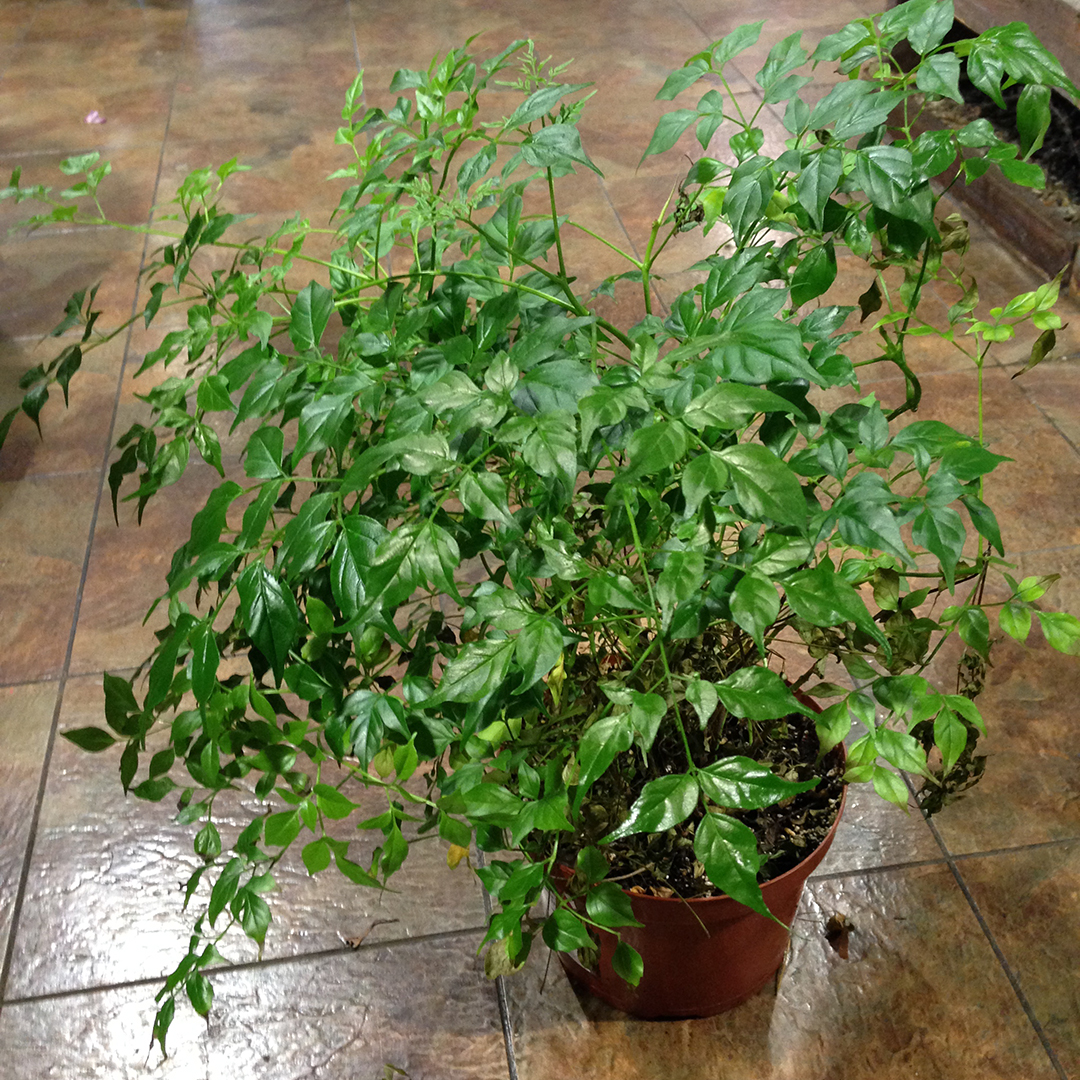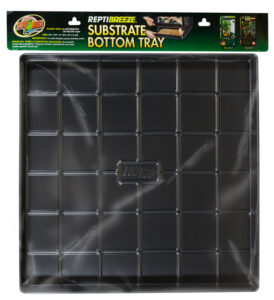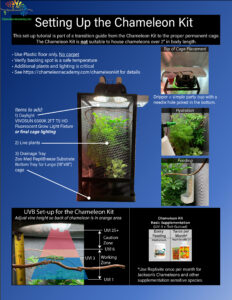What do I need for a hatchling Panther Chameleon?
Once you have a Panther Chameleon egg it is time to get ready for a panther chameleon hatchling. Although the due date may be months away it is best to get things up and running as soon as possible. Panther chameleon eggs will hatch whenever they want to and you don’t want to be caught unprepared! Today we start the preparations by discussing necessary cage and equipment.
Note that I am an Amazon affiliate. I may get some compensation if you use the links from Amazon.
Listen to this episode
Getting Prepared for a Panther Chameleon Hatchling
One thing you will have to get used to when preparing for a chameleon hatchling is that most every care guide you read when you research is for a subadult or adult chameleon. While these conditions can absolutely be used for a hatchling, you would have to keep the hatchling in an adult size cage. A sensible reaction would be that a baby hatches into the big wide world so it should do fine in an adult size cage. And you would be right. I happen to be someone that has no problem putting a tiny hatchling into a 2’x2’x4’ size cage. And they do great! But there is a little more in the way of strategy that is required in the execution.
Usually, though, hatchlings are raised in much smaller cages by breeders who are raising an entire clutch and so space is definitely at a premium. So we have this strange situation where almost all the husbandry advice is for well started Juvenile or adult panther chameleons. And almost all the hatchling care experience rests with breeders who optimize their husbandry for tens of babies. So there hasn’t been much done to develop the niche application of raising one hatchling in luxury. And that is what we are going to do here! I might be saying his a lot, but don’t be concerned if what I am directing here is different than what you hear elsewhere. That is because what we are doing is different than what is generally done!
The reason I want to bring this up is that I had to make a decision for this podcast and that is what cage set-up to choose to teach from. This perspective of raising one hatchling as the only child. And spoiling it rotten – really hasn’t been done before! So we are breaking new ground here!
The fact is that you can be successful creating a hatchling cage for growing up and then transition to an adult cage. And you can be successful just raising the hatchling in the adult cage from the start. Both of these will work. I struggled to pick which one to go with for this tutorial. In the end I decided I would teach from the method of starting with a hatchling grow-out cage and transitioning to the adult cage. The benefits of this approach are that it is easer to fill the cage appropriately, manage where your hatching is, and learn the basics of chameleon care. The drawback is that it is more expensive because you are setting up two cages. But I also think you will get more enjoyment starting off smaller. I do love starting out big, but that is because I enjoy not knowing if I will be able to see my chameleon at any given time. The first time chameleon keeper probably doesn’t have that perspective yet! That said, I am going to add sections onto each tutorial episode as to how to scale up the principles to the adult size cage. So, if you have a different cage then don’t worry, you’ll know what to do. Just be patient as I go through the details of the cage system I have selected to teach from. The details may be different, but the concepts will be the same. You’ll be able to apply them to the cage you have.
Now, even at the hatchling cage level there are decisions I have to make. Some people want to get through his stage as quickly as possible to get to the adult size. They’ll use plastic bins and plastic plants and give the bare minimum to cut costs and effort. They are wanting to get through this stage as quickly and cheaply as possible to get to the big adult.
And that is not what we are going to do here.
You are taking on a greater care burden by starting with a hatchling. And you are here listening, researching, and studying to make that work.
I have chosen to treat the months of growing from a hatchling to a juvenile as a very special time and I want you to create the best memory of this brief time.
You see, this experience should be some thing special for you. You are hatching out one of the most incredible creatures on this earth that is like no other. It will change color, have eyes that move independently, zap its food with a tongue longer than its body, move through the trees with feet fused together in an optimal branch grabbing shape, and can hang from branches with a fully prehensile tail. This is an experience worthy of becoming a special memory and I want this to be as incredible for you, and nurturing for your chameleon as possible! I acknowledge that some of you bought an egg because you thought it would be cheaper than getting a juvenile. I am hoping that you will not try and get through the first three months as cheaply as possible because you will miss out on one of the most special times in a chameleon keeper’s life.
I intend to make sure this is an experience you will remember for the rest of your life. And I will recommend the equipment that will help make that happen. I won’t go over the top extravagant, but I won’t cut corners either!
So I am going to present a system where you make a fully functional, and beautiful, hatchling to juvenile cage system.
So, yes, with this method, you will end up putting together two complete set-ups. There will be some equipment overlap, but I am constructing this tutorial with the priority on creating the best husbandry and learning experience. Rest assured that I have used this system and equipment list multiple times with success. I have been treating hatchlings individually and like kings and queens for years. And love using this method.
Panther Chameleon Hatchling Shopping List
Hatchling Cage
The cage I have selected for this course is the ZooMed Chameleon Kit. This kit will be highly controversial as it is universally despised by the chameleon community because the UVB bulb is woefully weak and the cage is too small for chameleons beyond four to five months old. The Chameleon Kit is, unfortunately, sold alongside reptile sales of chameleons. And, retail sales of chameleons are generally over three months old. So, yes, in almost all cases in the retail sales of chameleons, the Chameleon Kit is not an appropriate husbandry item. The UVB bulb is ineffective unless you know exactly where to put the basking vine or branch and the chameleon is small enough to fit in the small zone of UVI 3 that exists for only a half an inch a couple inches in front of the bulb. It deserves the bad reputation that it has. But, in this special case, the 16”x16”x30” cage is the perfect size for a hatchling to stretch out and not get lost. That Compact Fluorescent Lamp UVB bulb with a very small effective zone is just right for a hatchling panther chameleon to fit inside the cone of light. We don’t want the UVB so powerful that it radiates the entire cage because the baby needs to be able to get out of it. And, lo and behold, the weakness of the included Repitsun 13W, 5.0 CFL suddenly becomes, in this one specialized case, a desirable feature!
From this kit we will use the cage, the vine, the lights and light fixture, the thermometer, and the supplements. Although we will have to supplement the light, this kit has an adequate basking and UVB bulb for our purposes.
Daylight
Lighting your cage is one of the biggest decision point because there are so many choices, but not a whole lot of good ones! Chameleon cages have traditionally been way too dark and so this is something we, generally, need to do better at. We break sunlight into three components, daylight for vision, UVB for vitamin D3 conversion, and heat for temperature control.
The Chameleon Kit comes with a dual fixture which has a heat bulb and a UVB bulb. We will be replacing both the UVB bulb and the heat bulb for the adult cage, but we can use these for the first three months of the hatchling’s life. There is a temperature probe that comes with the kit which is useful and we will use this to make sure the basking spot is a safe temperature.
One of the things not in the kit is daylight and I take care of that with an Arcadia Jungle Dawn 22” LED light bar. I have used this light for many years and it was worked well for me. It will light up your hatchling cage effectively and will be able to transition to your adult set-up.
Hydration
Lighting your cage is one of the biggest decision point because there are so many choices, but not a whole lot of good ones! Chameleon cages have traditionally been way too dark and so this is something we, generally, need to do better at. We break sunlight into three components, daylight for vision, UVB for vitamin D3 conversion, and heat for temperature control.
The Chameleon Kit comes with a dual fixture which has a heat bulb and a UVB bulb. We will be replacing both the UVB bulb and the heat bulb for the adult cage, but we can use these for the first three months of the hatchling’s life. There is a temperature probe that comes with the kit which is useful and we will use this to make sure the basking spot is a safe temperature.
One of the things not in the kit is daylight and I take care of that with an Arcadia Jungle Dawn 22” LED light bar. I have used this light for many years and it was worked well for me. It will light up your hatchling cage effectively and will be able to transition to your adult set-up.
Fogger
This fogger has been my go-to as it is top filling (you don’t have to take the reservoir off to fill it with water), it has a 4 Liter capacity, and it has a dual output hose so you can guide the fog to two areas in the cage. The timer is cyclic so is useless to us. It is best to plug it into a standard appliance timer and run it that way.
Hand mister
I have used so many hand mister and I have been less than enthused by them. This one is the exception. It gives a fine mist and you don’t feel like you are going to break it when you squeeze the trigger at the highest mist setting! I am glad to be able to recommend a mister to you that isn’t just checking the box. I actually like this one!
Drainage tray
When selecting the drainage tray note that they are called substrate trays and are meant to go inside the cage. We want them to go under the cage so we must purchase the next size up. So, if we are using the 16″x16″ footprint cage, we would buy the substrate tray for the 18″x18″ cage. Our cage will fit nicely inside the 18″x18″ tray!
Effective Plants and Branches for a Chameleon Hatchling

The internal environment needs to have two main sections. An open are where the chameleon can bask and se the world, and then perching areas that are hidden from view so they can feel secure. Chameleons are not fast animals and use not being seen as their prime defense. So, you, as the benevolent world builder, need to make sure they have ample places where they can feel safe. This is particularly important for babies that know they are living in a world where everything wants to eat them. The most intuitive and recommended by me way of producing this dynamic is to use live plants to create an area of thick foliage starting about five inches down from the top and extending at least to the middle of the cage. So you are looking for plants which are around two feet high and bushy. I have found that these are commonly available at home improvement stores
The vine that is include is going to be useful so hang on to that. One thing that is good to have time to do is find the right plants to put in the cage. The reason for the challenge is that you want them to be about 24 – 26” high and dense foliage. This gives the chameleon plenty of places to sit and hide.
I have used the following plant species with success
There are two Polyscias species that pop up. They are commonly called Aralias and they are sold as stumps that bush out. Both the Fabian and Ming varieties are common and work beautifully. You can check the website for photos.
Schefflera arboricola, the umbrella plant works well and even the ubiquitous Ficus benjamina. You are looking for pants with perchable stems or leaves and big enough leaves for hiding behind. I like to mix my plants to achieve both.
For branches you can use anything small enough for their little feet. If you are using the Chameleon Kit I make good use of the bendable vine they include in the kit. I zip tie it to the screen itself on either side so I can precisely place the vine to get the useable UVB and the right heat. You can, of course, so this with branches, but it is harder to do the exact placement with a ridged branch.

Aralia species. The one ont he left with the rounded leaves is “Fabian” while the variety with lacy leaves is “Ming”

The Schefflera arboricola, Umbrella Plant is one of the most useful plants for chameleon cages because of its intricate perching stems and wide leaf coverage.

The Weeping Fig, Ficus benjamina, is commonly available. Just look for one that is 24″ tall and has bushed out.

The China Doll, Radermachera sinica, is ideal for hatchling chameleons
Further Research into Plant use:
Of course, there is so much more than can be said about plants and setting up the cage. This is a summary. If you would like to dive deeper, here are relevant links:
Plants for Chameleon Cages: This page presents how to use plants in a chameleon cage and discusses plant toxicity and how it relates to chameleons.
Forest Edge 4+4 Method: This page introduces a simple method to put together a chameleon cage and to make sure you have fulfilled each important point.
Panther Chameleon Podcast Home Page
This is an episode of the Panther Chameleon Podcast which is an educational outreach of the Chameleon Academy. This podcast specializes in sharing Panther Chameleon husbandry. If you are interested in learning about Panther Chameleons then this podcast will guide you through what you need to know, step-by-step, assuming no prior experience. It is designed chronologically so you can start with episode 1. To go to the podcast home page, tap the link below.
Podcast Episode Transcript (More or Less)
Episode 3: Hatchling Chameleon Equipment
Caring for a hatchling chameleon has many similarities with caring for juvenile or adult Panther Chameleons, but there is increased sensitivity and increased chance of overdoing heat, UVB, or water or anything! This episode will start from ground zero with hatchling care in mind.
Welcome to the Panther Chameleon Podcast. My name is Bill Strand and I will be your guide through the life sages of the incredible panther chameleon.
You may be surprised by the reaction you get when you digitally walk into the chameleon community social media world and share that you have purchased an egg. You will likely be met with some very strong feelings against the sale of chameleon eggs. You might be caught off guard because there was no indication before that point that hatching an egg was anything but an easy, cheaper, and fun way of getting involved with chameleons. On my main podcast, the Chameleon Academy Podcast I have had a number of episodes where we discuss the ethics and challenges of the practice. But I would encourage you to not get caught up in those discussions. The time for those discussions was while you are thinking about whether to get an egg or a well started juvenile. If you have already purchased an egg then what is done is done. You have already signed up for this ride! The good news is that most of the complaints about people purchasing an egg center around having people who have never had a chameleon before starting with a chameleon at the absolute most challenging stage of life! People have trouble with well-started chameleons. The idea that people are starting with hatchlings makes the experienced community put their heads in the hands and cry a little bit. Just take a look at some of the situations on social media and you will understand why the thought of someone starting with a hatchling is looked down upon! But the reason why chameleons are considered hard is not because they are hard with the correct husbandry. And we know enough that you can set them up correctly if you get the right information. It is just that the knowledge of how to set them up correctly somehow has not trickled down to pet stores and reptile expos. It has been here for anyone to access for many years. It just takes someone to do the search. And, here is the tricky part, they need to search in the right places. A quick Google search for chameleon care turns up corporate websites and ad/affiliate sites. You sometimes don’t get to the websites from people that actually keep chameleons for a page or two of search results. We are working hard to change that, but getting good information is not as simple as just typing in some search terms! The problem is that when you type in search terms or talk to the pet store employee (and they should be the experts, right), you get back reasonable sounding answers. Sure, an experienced chameleon keeper can tell where the problems in the advice are, but for someone new, it all sounds reasonable and definitive. It is unfortunate how difficult it is to tap into the good veins of experienced knowledge and how legitimate the shaky type stuff sounds.
The advantage you have is that you are here and I will be able to present to you the way to hatch and raise a chameleon successfully. I have been both a breeder and an educator for decades. So, you will have the advantage of starting out with solid information from the beginning. The very tough thing about hatchlings vs well started juveniles is that you have second and third chances to get it right with an older chameleon. You do not get a second chance to get it right with a hatchling. And if something is wrong you may not even get a warning before the baby is too far gone. So the key is to find the right information and do not cut corners. You have found a place for the right information and, so, you are in the best position to be successful. But do not cut corners. Do not treat your baby set-up as temporary. Like I said, you do not get second chances with a hatchling. You do not get warning signs. By time you see something is wrong it is usually too late. So you have to treat the baby set-up seriously even though you will be using it for about three to four months before graduating to an adult set-up.
One thing you will have to get used to when preparing for a chameleon hatchling is that most every care guide you read when you research is for a subadult or adult chameleon. While these conditions can absolutely be used for a hatchling, you would have to keep the hatchling in an adult size cage. A sensible reaction would be that a baby hatches into the big wide world so it should do fine in an adult size cage. And you would be right. I happen to be someone that has no problem putting a tiny hatchling into a 2’x2’x4’ size cage. And they do great! But there is a little more in the way of strategy that is required in the execution.
Usually, though, hatchlings are raised in much smaller cages by breeders who are raising an entire clutch and so space is definitely at a premium. So we have this strange situation where almost all the husbandry advice is for well started Juvenile or adult panther chameleons. And almost all the hatchling care experience rests with breeders who optimize their husbandry for tens of babies.
So There hasn’t been much done as far as educational content for the niche application of raising one hatchling in luxury and spoiling them rotten. And that is what we are going to do here!
Now, we need to get something out of the way. We in the community always run into problems when someone thinks that chameleon keeping can be done cheaply. “Cheaply” is a relative term and means something different for everyone. But when people start deciding whether they are going to get a certain piece of equipment based on the cost rather than the need by the chameleon you can see where we have problems of which the chameleon will bear the entirety of the consequences.
I bring this up because I know that a major marketing push that may have been part of convincing you to purchase an egg was that it was a cheaper way to get into chameleons. While, yes, it is a cheaper way to do the initial purchase, to do a true comparison, you have to add the cost of initial purchase to the cost of raising your hatchling up to the three month mark where you would have purchased a well started juvenile. You will end up spending more on the egg purchase once you get to three months old. True, it will be spread out, but I want to get us out of a cost savings mindset. We do not have to record and compare numbers, but now it is time for the equipment purchase and when the egg hatches it will be time for learning how much it costs for food!
I love raising up babies and I so want to impart that wonder and enjoyment, but we have to wipe away the idea that this will be cheap or simple. I fully realize that you probably weren’t made aware of the costs of chameleon ownership and that what I am presenting may be a shock. I wish there was a way to go back to the point of sale and provide all this to you there! But we are here now and will go forward.
So, here is the agreement I will make with you. I will present to you the best cage set-up and hatchling raising experience for your chameleon and you don’t cut corners. I won’t be extravagant – there is no need for that – but what I present is necessary. I have kept and raised hatchlings in professional breeder set-ups, adult cages, plastic bins, and in full featured mid sized cages. Through all of these different methods the one that stands out as the most effective and easiest way to raise a hatchling is with the full-featured mid-size cage that allows the hatchling to stretch out, move around, but still is a manageable space for you to effectively fill. And I will spend the entire series going over each aspect in detail so you are able to do this yourself. The series will close with the transition to the adult cage set-up which will be in three to four months after hatching. I do understand that some of you may already have a cage and so I will talk about the concepts so that you can scale them for your particular situation.
You will be successful if you treat these first four months as a special time and invest in them. Your hatchling has a strong will to live and will be able to do that and grow strong if you provide to them what they need.
And that is exactly what we are going to do here. We are going to spoil your hatchling rotten and raise it up to think it is royalty.
That said, let’s get on with hatching that egg. Let’s assume you have your egg and that now you have a couple months to get ready. Although you should have those months to slowly get everything together, I will also encourage that you don’t procrastinate. It pays to go through the steps at a brisk pace. That egg will hatch when it feels like it and it is a big pain to not be ready when the baby hatches early! Later than expected is better because it just means your entire set-up is sitting there waiting, but earlier means you may not be ready!
Tasks to perform while your chameleon egg is incubating
You will have three main tasks while your egg is incubating. The first is to get prepared for what the incubation process is. You need to know what to expect and be ready for. The next episode in the series will address exactly that. I will talk about what healthy eggs look like, and signs that your egg is not healthy. I will also guide you through the hatching process. It really isn’t that complicated, but you just need to know what is going to happen!
The second task is to set up the cage. There will be many episodes as part of this step because here is where you will learn chameleon husbandry. The reason why there will be so many is because once you understand the reason for the interior design, the lighting, and the hydration methods you will be able to troubleshoot if things are not going as expected. I want you to have that background and knowledge.
Your third task is to prepare for feeding your little tyke. Yep, it is time to come to terms with offering live food. Not only that, but caring for insects to ensure they are in top health. Your chameleon is what it eats!
After that we will touch on how to care for a growing chameleon and how to transition to the adult size cage, care, and feeding. We will close up with a guide to chameleon behavior and a medical overview so you know what to look out for and how to nip problems in the bud before they get big enough to make your baby sick. You are free to jump around, of course, but this series has been designed to be watched or listened to in chronological order as each episode builds on the previous.
I am actually going to start with that second step, putting together a cage, today so we can get equipment on order. Cage set-up will take the bulk of our time so we need to get it started right away. Once things are coming in the mail we can review the incubation process.
I have a shopping list for all the items I am using on the show notes page for this episode. You can find it on the chameleon academy dot com website. This will have links to everything you need to get started. If you haven’t checked out the chameleonacademy.com website, I make it very easy to find the Panther Chameleon material from the home page. Just go to chameleonacademy dot com and you’ll be directed to the place you need to go.
Equipment for your chameleon
I am going to give an overview of the equipment now. It will be just enough that you understand what you are purchasing, but the major functions of the cage, the interior, the lighting, and the hydration will have complete episodes on their own.
There are many combinations of equipment that will work. If you are experienced and have your own way of doing things then more power to you. There are pros and cons to each set-up choice.
I have chosen the pieces I will use for my example based on affordability, availability, function for the first time keeper, and application to the adult set-up.
The Hatchling Chameleon Cage
Since babies are small they are generally raised in smaller cages. This is not because the baby would be overwhelmed by a large cage. Baby panther chameleons can be successfully raised in a Madagascar size cage. Chameleon babies are raised in smaller cages so we humans, who have this infernal need to check on things often, can have a decent chance of finding our baby in the cage. Many cage types can be used from the simple and very temporary butterfly cage to the professional nursery style cages to even an adult size cage for those keepers who know what they are doing and aren’t bothered by not being able to see their baby every day!
The cage I have selected for this course is the ZooMed Chameleon Kit. This kit will be highly controversial as it is universally despised by the chameleon community because the UVB bulb is woefully weak and the cage is too small for chameleons beyond four to five months old. The Chameleon Kit is, unfortunately, sold alongside reptile sales of chameleons. And, retail sales of chameleons are generally over three months old. So, yes, in almost all cases in the retail sales of chameleons the Chameleon Kit is not an appropriate husbandry item. The UVB bulb is ineffective unless you know exactly where to put the basking vine or branch and the chameleon is small enough to fit in the small zone of UVI 3 that exists for only a half an inch a couple inches in front of the bulb. It deserves the bad reputation that it has. But, in this special case, the 16”x16”x30” cage is the perfect size for a hatchling to stretch out and not get lost. That ineffective Compact Fluorescent Lamp UVB bulb….well, that very small effective zone is big enough for a hatchling panther chameleon to fit inside. We don’t want the UVB so powerful that it radiates the entire cage because the baby needs to be able to get out of it. And, lo and behold, the weakness of the included Repitsun 13W, 5.0 CFL suddenly becomes, in this one specialized case, a desirable feature!
But I do have to make a note that just the mention of the Chameleon Kit or you posting a picture of using the Chameleon Kit will illicit a huge negative response from people on social media about how you have to change that right now or your chameleon will die. They call it the death kit. I want to let you know that they are correct within the context of what they usually are exposed to. But I also want you to know that hatchling care is a different beast and you are getting expert instruction from someone who is 100% aware of the situation with the Chameleon kit. I have, myself, done a great deal of community awareness of how dangerous this kit can be. A good portion of this danger is because the UVB bulb is so weak that you may think you have UVB for your chameleon when you really don’t and MBD, or calcium deficiency, is a scourge of our community. But when we have a hatchling we do not want the typical T5 UVB bulb that we use for adults as it is too powerful. We can use it, but we have to prop it above the cage to let the intense UVB levels dissipate before your hatchling can get exposed to it and then offer dense foliage for the hatchling to be able to escape the UVB. UVB is what gives you sunburns and skin cancer. We need it to create vitamin D3, but too much and we burn. The weak UVB in the Chameleon Kit is actually a benefit in this situation. In this one and only situation. So, when you run into a wall of panic and concern I want you to simultaneously remember that they are right to be concerned, but also that you are being guided by an expert who 100% understands the concerns and also understands why this is actually a very good solution for this exact application. So, don’t get into any fights. If, or when, you get push back, your response can be, “Yes, I know the dangers in using the Chameleon Kit, but I am being guided in how to use it safely and effectively as I transition to my chameleon’s adult set-up”. And you are welcome to say you are working with me and that they can check out this podcast to understand what I am doing. Many admins of social media groups will have never heard of such a thing so do not be surprised if they aren’t easily convinced.
And I want to take a sidebar here for the people who are already part of the community and already have strong opinions against the Chameleon Kit. This is a perfect lesson of how we should understand the tools. Most people would love to say the Chameleon kit is bad and should never be used. Well, here is a way that actually learning about the product’s limitation is a benefit. Yes, it is a poor product for young adult chameleons, but it is a great tool for bringing up one hatchling. And this isn’t hypothetical, I have been raising Veiled Chameleon and panther chameleon hatchlings in a Chameleon Kit using this method specifically to work out the bugs and be able to teach using this tool. It really is very simple when you understand the tools. You are absolutely correct that this is a faulty product for the marketing behind it. This is no reason to change your cautions and concerns when you are advising people on line. But realize that the negatives of this kit when used with a larger chameleon are actually positives with a hatchling when done exactly correctly. And I am taking on the burden and responsibility to do that. By time the new keepers going through this podcast course are done the chameleon will be in its adult cage with the husbandry that is commonly understood in the general community. So, just know, I am aware of all the concerns and, still, feel like this is a highly effective tool for a new keepers to raise up a hatchling. I am taking the responsibility to guide my listeners from egg incubation until chameleon adulthood. And I invite you to come along and listen to the entire series to fully understand what I am doing here.
Now, back to the main event. When shopping you may run into the Deluxe Chameleon Kit. This kit has a larger cage and a much more powerful UVB light. This kit can be used, but you’ll have to scale every up for the taller cage and take care to raise the UVB light about three inches above the cage due to its strength. But I am going to use the standard ZooMed Chameleon Kit.
The screen cage of the standard Chameleon Kit is 16” x 16” x 30”. This is big enough that you can actually create a nice plant filled environment, but still be able to keep track of your baby. Cage size and type is a huge topic with many Chameleon Academy. podcast episodes, videos, and web pages. But you don’t need all that information right now. We are going to stick with one direction and focus on that! Just know that everyone will have their own way to do it and may feel deeply attached to their decisions enough that they passionately respond to anything different. All is good. Now, when you are shopping for this cage you can just purchase from the link in the shopping list.
One item on this list that may seem strange is a shrink wrap window insulation kit. This is an item that is part of our hydration strategy. It is an inexpensive way to help you control humidity and mist overspray. So I will be talking about it in the hydration episode. The top level overview, though, is that this kit has double sided tape that you can put along the outer frames and then the shrink wrap film sticks on the tape. A quick hair dryer session to heat the film and you have a clear wall that will hold in humidity and keep the walls and furniture safe from mist going out the opposite end of the cage. Hey, keeping your spouse happy is all part of this project! Like I said, I have been doing this for years and have learned a lot!
That segues us over into hydration which I have both a fogger and a hand pump mister. If you have been around the chameleon community you are sure to have run into our common usage of automated misting systems. I did not elect for using one for our hatchling for the simple fact that chameleons hate to be sprayed. In fact, just this morning I did a gentle hand spray, careful to avoid hitting the baby as much as possible, but slipped and the baby got the edge of the mist cloud. But that was surprising enough that he simply dropped off his branch to the floor of the cage. We can get away with misters in larger cages because there is so much more space for the mist to dissipate before hitting the chameleon and the larger chameleons have less shock value to droplets that are relatively smaller to their body size. Though, they still hate it! The hand mister allows you to be careful where you aim the mist and when. An automated mister goes off without regard to where the chameleon is.
And this is why I elected to use a fogger to help with hydration. A fogging takes longer than a mister to be effective, but it is much more gentle. And in good conditions, leaves a dew covered interior and may be all the hydration your baby needs. We will also introduce using party cups as drippers, but we probably don’t need a special shopping trip for that!
Light for Hatchling Chameleons
Lighting your cage is one of the biggest decision point because there are so many choices, but not a whole lot of good ones! Chameleon cages have traditionally been way too dark and so this is something we, generally, need to do better at. We break sunlight into three components, daylight for vision, UVB for vitamin D3 conversion, and heat for temperature control.
The Chameleon Kit comes with a dual fixture which has a heat bulb and a UVB bulb. We will be replacing both the UVB bulb and the heat bulb for the adult cage, but we can use these for the first three months of the hatchling’s life. There is a temperature probe that comes with the kit which is useful and we will use this to make sure the basking spot is a safe temperature.
One of the things not in the kit is daylight and I take care of that with an Arcadia Jungle Dawn 22” LED light bar. I have used this light for many years and it was worked well for me. It will light up your hatchling cage effectively and will be able to transition to your adult set-up.
Chameleon Hatchling Shopping List
There are many other odds and ends on the shopping list which I have on the website. Going over all the pieces will be much more meaningful when I get to reviewing how to use them and so you can use that list as a reference as the episodes go on and I discuss how I use each one. You can purchase when you feel confident in your direction.
The Chameleon Community
You may notice that I commonly add in discussion about chameleon community politics, drama, and issues. I do this because you are likely to be part of the chameleon community at some point in some manner. You may find the chameleon forums and enjoy that, more quiet, hang out. Or you might jump into Facebook and Reddit and search for “chameleon”. Some people think that it is best to figure out chameleon care by committee where they join every social media group and compare care opinions. I can tell you right now that they are all different and will be presented to you as the one true way to do it. It will be very confusing to you and leave you wondering what to think. My advice to you is to research the people giving the advice and pick the one source you trust the most. We all leave a sort of digital footprint these days and so Google is your friend to figure out who you want to listen to. Go ahead and Google “Bill Strand Chameleon” for my history in the chameleon world. I shouldn’t be immune to that because everyone will tell you that you should listen to them! Do that with all your experts and you will find an effective filtering process. You are welcome to check out all the different views on husbandry, but you will go crazy unless you decide which one approach you will follow. Nothing says you have to stay with that view forever, but I highly suggest you pick one to start with. And, by the way, make sure they have actually worked with hatchlings. You might be surprised how many people will state with authority something they expertly read somewhere. One thing to remember, if you can’t help, but gather multiple opinions, is that you can’t mix and match parts of the husbandry. All parts of husbandry are intertwined and depend on each other. Decide on who you trust and use every part of their method. Do not mix and match!
But, I do hope you are happy here. I do not believe you will find a more comprehensive tutorial that will handhold you through this entire process.
Okay, I am going to close up here. In the upcoming episodes you will be getting that deep dive into setting up the hatchling environment. But first, I am going to talk about the incubation process so you know exactly what to look for. Incubation can be a nerve wracking time, but once you know what is going on you can feel more at ease. Lots to look forward to!
I hope this was an educational episode and that you feel confident that you know what to get for your hatchling.
At this point, I would like to invite you to join one or both of my weekly live sessions. As of the release of this episode I have one on Chameleon Academy Instagram account Tuesday nights at 5PM Pacific time and one on the Chameleon Academy YouTube account at 12 noon Pacific on Saturdays. These live events are informal and interactive. I take questions from the crowd and there are conversations that go on in the chat. It is a chance for community members to get together in real time. Often the Saturday session also has a guest if the episode released for the Chameleon Academy Podcast on Friday had a guest. I like to interview someone, release the episode on Friday and then have them come on Saturday so the community can answer questions of them directly. You are welcome to come and interact or just sit back and enjoy the banter. That is Saturday’s, noon Pacific on Youtube or Tuesday evenings at 5PM Pacific on Instagram. This would be an opportunity for you to ask any questions you might have as you are going through these modules.
Remember to go and check out the show notes where you can find further information and research points t continue your education.
Thank you for joining me here. This is Bill Strand signing off. I will see you next time!
Panther Chameleon Podcast Home Page
This is an episode of the Panther Chameleon Podcast which is an educational outreach of the Chameleon Academy. This podcast specializes in sharing Panther Chameleon husbandry. If you are interested in learning about Panther Chameleons then this podcast will guide you through what you need to know, step-by-step, assuming no prior experience. It is designed chronologically so you can start with episode 1. To go to the podcast home page, tap the link below.













